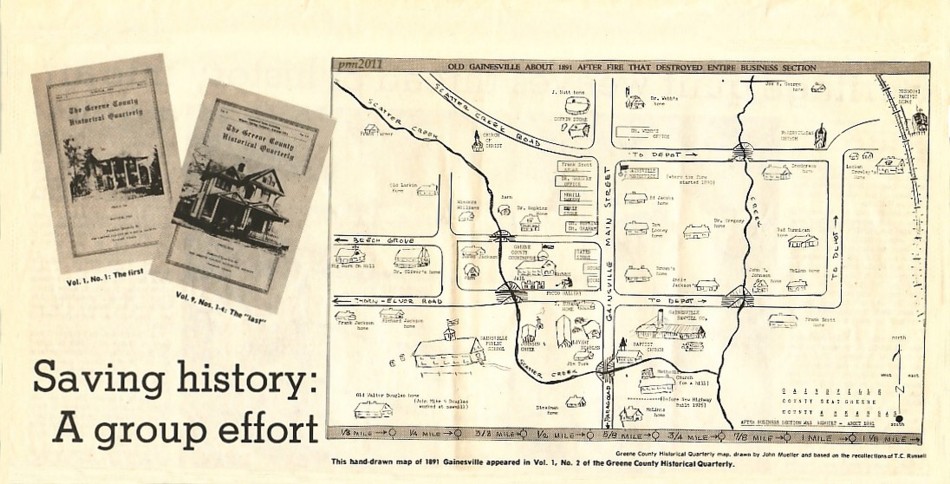| "Don't just remember --
write it down."
That admonition appears in one of the 28 issues
of the Greene County Historical Quarterly, a 10-year collective
labor of love that helped preserve numerous slices of the county's
history.
Those 28 issues of the Quarterly, dated from Winter 1964 to Autumn
1974, contain almost 700 pages of written history, a galaxy of
infor-mation -- stories, community histories, old photo-graphs,
biographies, family trees, cemetery listings and military rosters.
Much of the information would have been lost if it hadn't been
written down while the storytellers were still around, for many of
the oldtimers who were eyewitnesses to the county's development or
who vividly remembered the stories their parents told of early
settlement have died.
Fortunately, the Greene County Historical Society, which published
the quarterly for 10 years despite the financial and organizational
odds, was able to preserve at least a part of the county's history.
The historical association was organized in June 1964, with
assistance from interested persons from Arkansas State University
and the Craig-head County Historical Society. Its first quarterly
was published that winter.
The group was able to crank out four issues a year for six years.
But in the seventh year, finan-cial and other problems forced the
society to produce only two issues instead of four. In each its last
two years, 1973 and '74, the society produced single combined
issues, the "combined
issue including winter, spring, summer, autumn 1974" being its last
until an attempt this centennial year to revive the quarterly and
the society. (See related story below.)
The foreword at the front of each of the issues charts the lack of
funds and participation that ultimately brought about the suspension
of the quarterly. |
|
But in the
beginning, the group started with high
aspirations. President Raymond Frey's message in the first issue mentions
plans for placing historical markers at significant sites and taping
oral history interviews with older citizens.
"The aim of the Society is to find and preserve the history of
Greene County. Much of the early history has already disappeared, as
old landmarks are erased and the elder citizens leave the passing
scene," Frey wrote in the foreword which also solicited memberships
and written contributions.
In the second issue he praised "the enthusiastic response" the
first had generated, especially the "constant flow of letters from
many former Greene County citizens from California to the East
Coast." In fact, Frey said recently, former residents responded much
more enthusiastically
than those still living in the county, an irony he alluded to in
that second foreword. "While the membership now numbers over 100 and
almost three-fourths of the first edition of the Quarterly have been
sold, there are still many Greene County citizens whose families
have deep historic ties with this region, and should be interested
in helping support the work of the Society," he wrote.
He also mentioned other problems that would nag the society
throughout its existence. "This issue is necessarily limited in size
because of the presently small membership and lack of funds." In
fact, the first issue had been financed solely throu- gh Mrs. W. L.
Skaggs' purchase of a $100 life membership. She was the only one to
buy such a patron membership during the existence of the
organization.
The society met monthly at the libary and later at the then-new
community center. Papers were presented and matters discussed but,
especially in later years, few people showed up.
Reliance on a handful of key people posed problems for the
fledgling group. |
|
Apologies for late issues
usually cited the sick-ness of some officer or editor. Money
problems resurfaced from issue to issue.
"We hope the members understand the com-plications of publishing a
magazine on the pro-verbial shoe-string,"one message stated. "The
fact that the Quarterly eventually finds its way into print is the
result of the dedication of a handful of members who have worked
unceasingly in pro-moting memberships, collecting dues and
donations, selling copies of the Quarterly in order
to pay the printing bill and other small obligations the operation
of the Society entails."
And, it continued, "It is something of a task to find historical
material of sufficient interest for each issue.Many promise to get
historical data to us, but materializaion is slow. The Editor again
solicits your family's histories and memories of historic interest,
so that your magazine may be filled with items that should be
preserved."
In almost every issue there was an apology for lateness caused by
finances, pleas for help with projects such as mapping cemeteries,
saving the Crowley home or planning historical markers and request
for members to, please, attend the meetings.
In late 1971, the society reported a record membership of 800,but
the signs of trouble were still there.
One of the last issues of the Quarterly contains what amounts to
its own obituary.
After summarizing the history of the organization the writer added,
"The long illness of several of the officers and the subsequent
deaths of the most dependable of the older members, disrupted the
continuity of the meetings. Attendance fell so low the meetings were
of a necessity discontinued. With the removal of Dr. C. W. Starnes,
the president, to Jonesboro, the work of the society has virtually
been halted."
The next issue was the last. |

